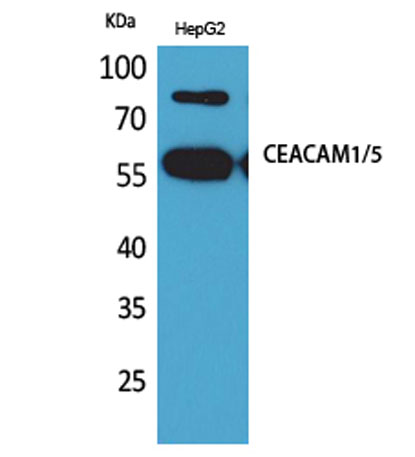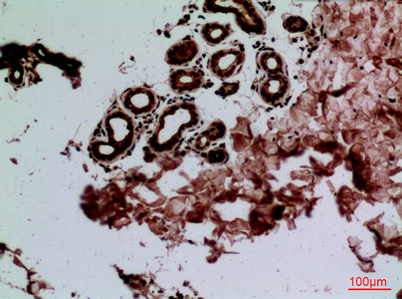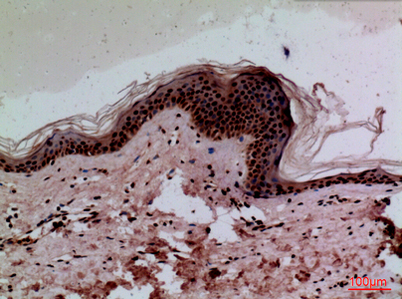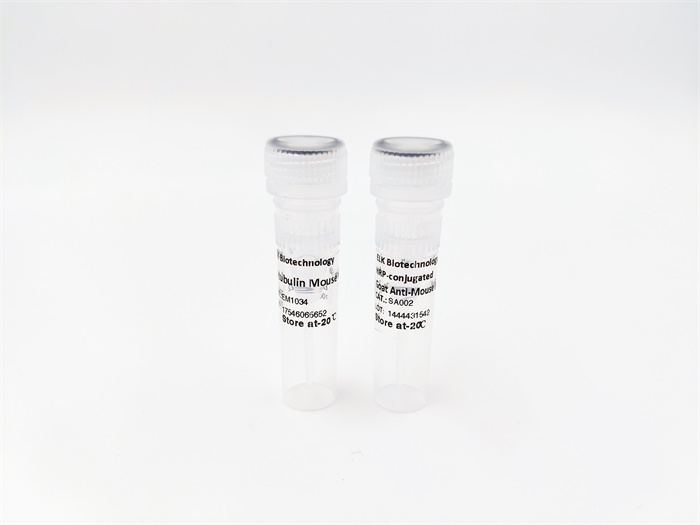| Product name: |
CEACAM1/5 rabbit pAb |
| Reactivity: |
Human;Rat;Mouse; |
| Alternative Names: |
CEACAM1; BGP; BGP1; Carcinoembryonic antigen-related cell adhesion molecule 1; Biliary glycoprotein 1; BGP-1; CD66a; CEACAM5; CEA; Carcinoembryonic antigen-related cell adhesion molecule 5; Carcinoembryonic antigen; CEA; Meconium antigen 100; CD66e |
| Source: |
Rabbit |
| Dilutions: |
Western Blot: 1/500 - 1/2000. IHC-p: 1:100-300 ELISA: 1/20000. Not yet tested in other applications. |
| Immunogen: |
The antiserum was produced against synthesized peptide derived from the N-terminal region of human CEACAM1/CEACAM5. AA range:31-80 |
| Storage: |
-20°C/1 year |
| Clonality: |
Polyclonal |
| Isotype: |
IgG |
| Concentration: |
1 mg/ml |
| Observed Band: |
58kD |
| GeneID: |
634 |
| Human Swiss-Prot No: |
P13688 |
| Cellular localization: |
[Isoform 1]: Cell membrane ; Single-pass type I membrane protein . Lateral cell membrane . Apical cell membrane . Basal cell membrane . Cell junction . Cell junction, adherens junction . Canalicular domain of hepatocyte plasma membranes. Found as a mixture of monomer, dimer and oligomer in the plasma membrane. Occurs predominantly as cis-dimers and/or small cis-oligomers in the cell junction regions. Found as dimer in the solution. Predominantly localized to the lateral cell membranes. .; [Isoform 2]: Secreted .; [Isoform 3]: Secreted .; [Isoform 4]: Secreted .; [Isoform 5]: Cell membrane; Single-pass type I membrane protein.; [Isoform 6]: Cell membrane; Single-pass type I membrane protein.; [Isoform 7]: Cell membrane; Single-pass type I membrane protein.; [Isoform 8]: Cell membrane ; Sing |
| Background: |
This gene encodes a member of the carcinoembryonic antigen (CEA) gene family, which belongs to the immunoglobulin superfamily. Two subgroups of the CEA family, the CEA cell adhesion molecules and the pregnancy-specific glycoproteins, are located within a 1.2 Mb cluster on the long arm of chromosome 19. Eleven pseudogenes of the CEA cell adhesion molecule subgroup are also found in the cluster. The encoded protein was originally described in bile ducts of liver as biliary glycoprotein. Subsequently, it was found to be a cell-cell adhesion molecule detected on leukocytes, epithelia, and endothelia. The encoded protein mediates cell adhesion via homophilic as well as heterophilic binding to other proteins of the subgroup. Multiple cellular activities have been attributed to the encoded protein, including roles in the differentiation and arrangement of tissue thre |










 Western Blot analysis of HepG2 cells using CEACAM1/5 Polyclonal Antibody. Antibody was diluted at 1:1000. Secondary antibody(catalog#:RS0002) was diluted at 1:20000
Western Blot analysis of HepG2 cells using CEACAM1/5 Polyclonal Antibody. Antibody was diluted at 1:1000. Secondary antibody(catalog#:RS0002) was diluted at 1:20000 Immunohistochemical analysis of paraffin-embedded human-skin, antibody was diluted at 1:100
Immunohistochemical analysis of paraffin-embedded human-skin, antibody was diluted at 1:100 Immunohistochemical analysis of paraffin-embedded human-skin, antibody was diluted at 1:100
Immunohistochemical analysis of paraffin-embedded human-skin, antibody was diluted at 1:100 Immunohistochemical analysis of paraffin-embedded human-liver, antibody was diluted at 1:100
Immunohistochemical analysis of paraffin-embedded human-liver, antibody was diluted at 1:100
 Manual
Manual